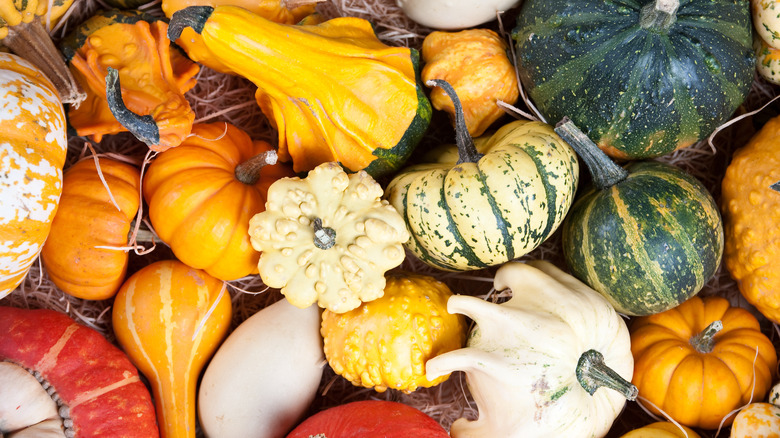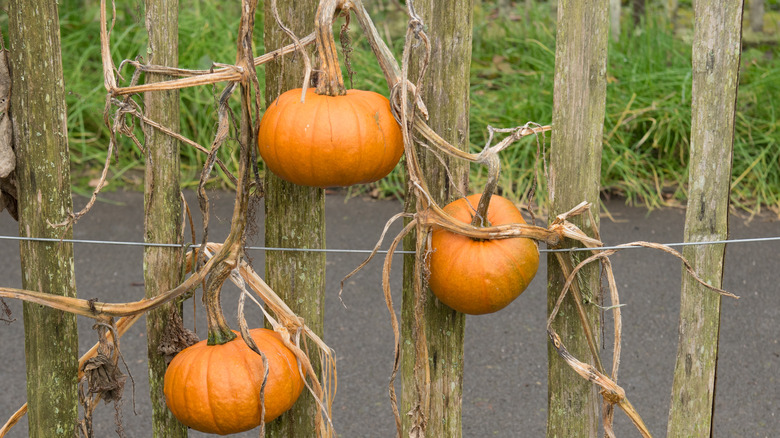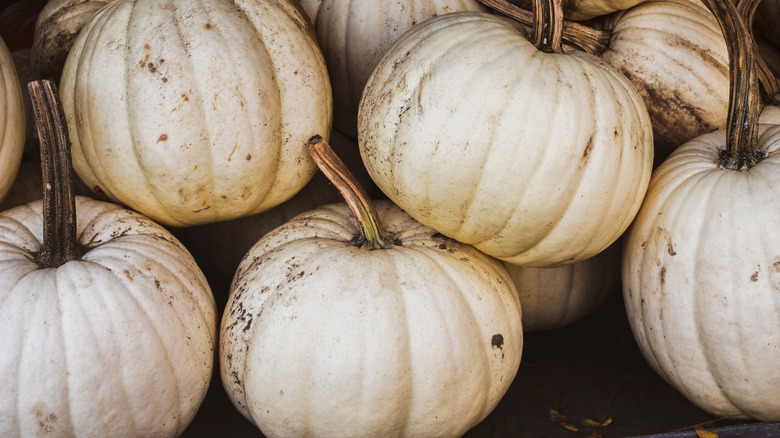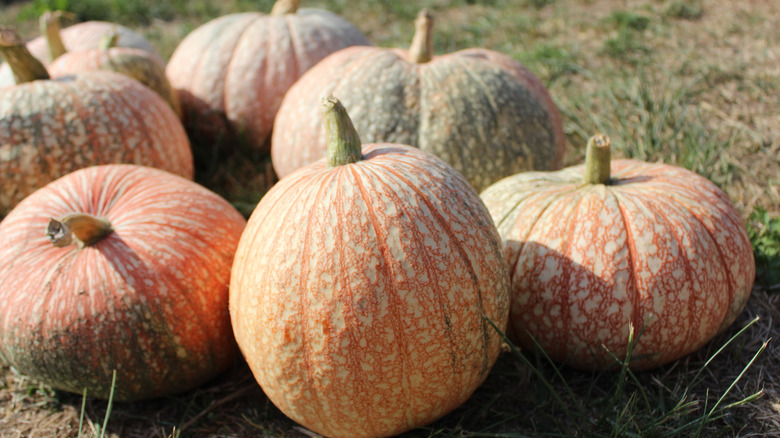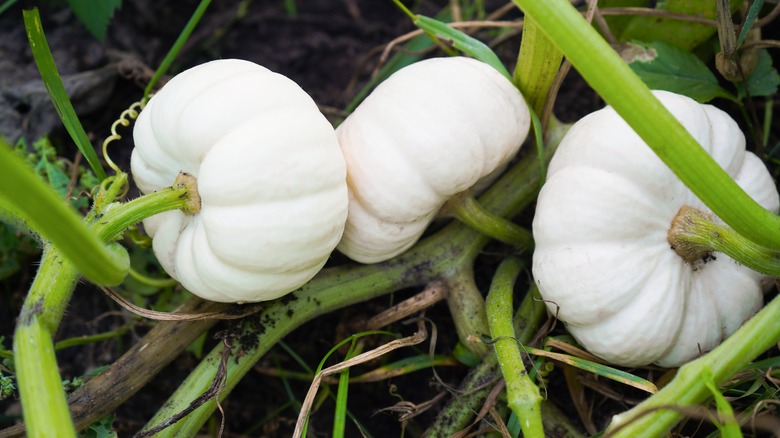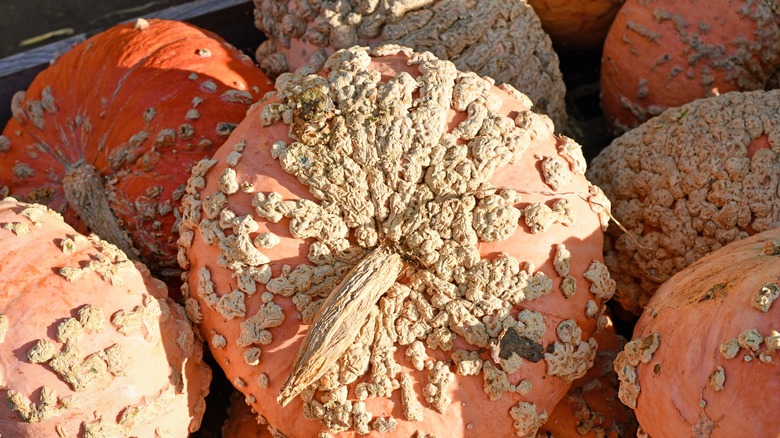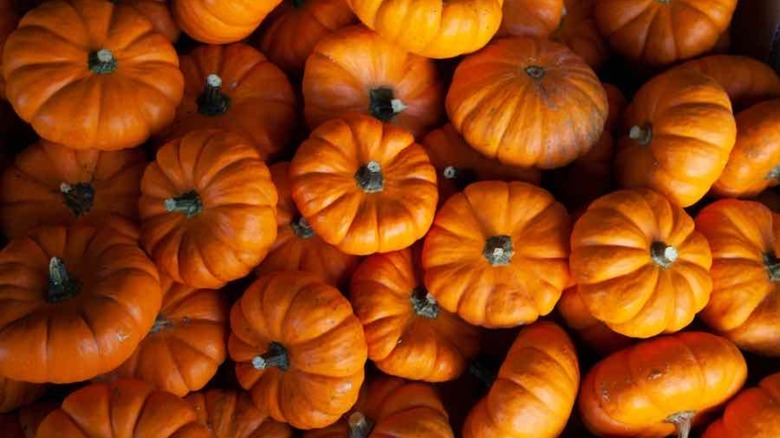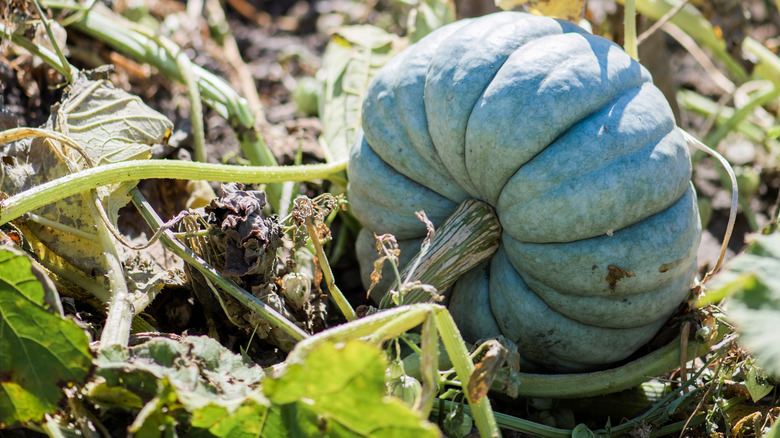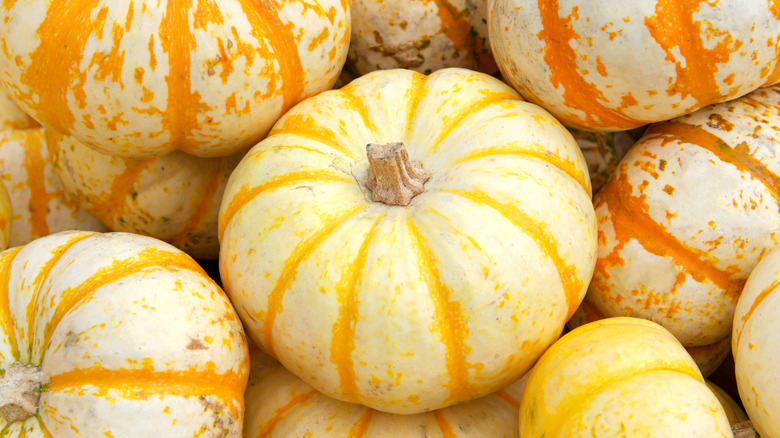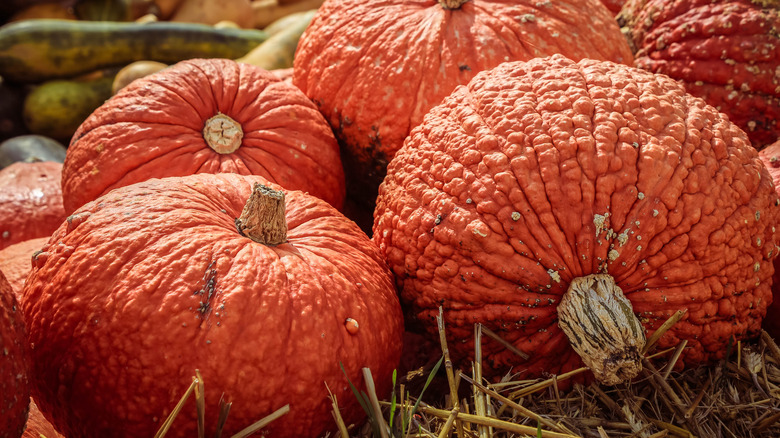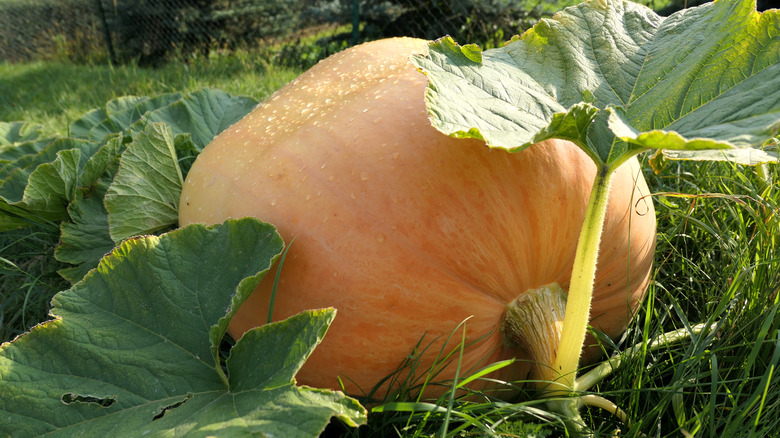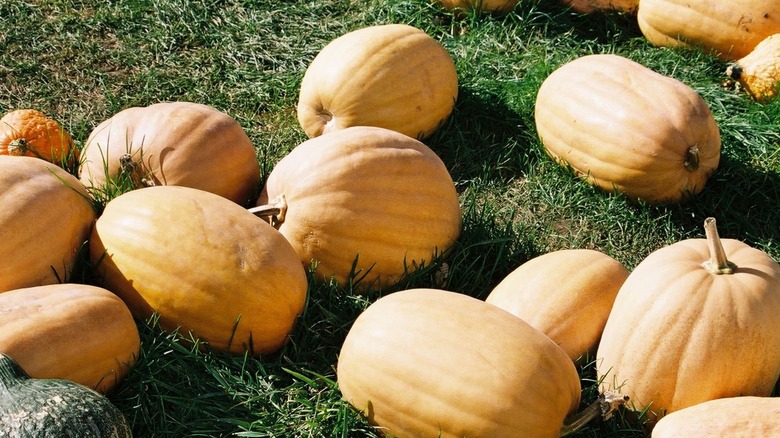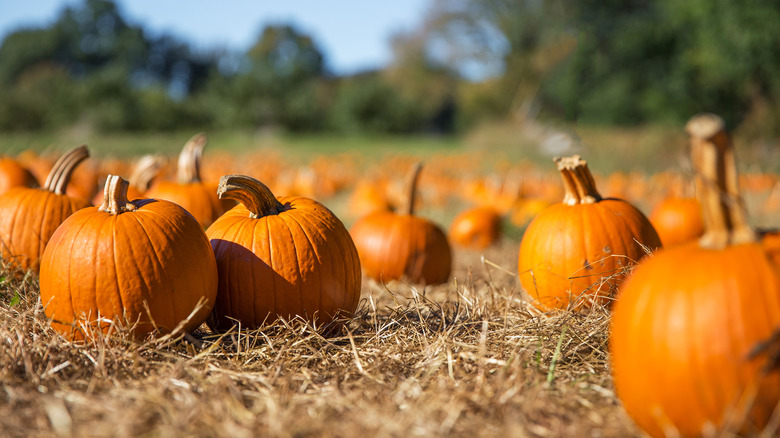The 12 Best Pumpkin Varieties To Plant In Your Garden
We may receive a commission on purchases made from links.
Your very own pumpkin patch spicing up the front yard is easier to achieve than you think. There are over 150 varieties of this autumn staple, and they all prefer the common growing conditions of full sun and nutrient-rich soil, so get your compost and fertilizer ready. You can find these fruits ranging in colors from gray-blue to bright orange. They also have different textures, from silky smooth to satisfyingly bumpy, and they come in various sizes — ones that fit in your palm and others you need a forklift to move.
When planting pumpkins, make sure there is sufficient room for the vines to travel and the fruit to sprout. However, if space is limited, there are miniature varieties that won't take over your backyard. Whether you already have your pumpkin recipes lined up or are planting these gourds to make the perfect DIY pumpkin bird feeder, we have best varieties even garden novices can tackle.
1. Baby bear
Baby bear pumpkins are a stellar mini variety that only weighs 1 ½ to 2 ½ pounds, perfect for small gardens or as a starter plant to dip your toes in pumpkin cultivation. While this small orange fruit is ideal for decorations like cornucopias, you can use its flesh for pies and roast its seeds for a tasty crunch. Baby bear pumpkins like well-drained soil, favor mulch, survive light frost, and take approximately 105 days to mature.
2. Casper
For a sweet white pumpkin, great for desserts and decor, Casper is the variety for you. This species reaches up to 15 pounds and is hardy in zones 3 to 12. It requires lots of water and nutrients. Feed your Casper pumpkin fertilizer high in nitrogen, give it 6 hours of sunlight, and water it at least 1 inch per week for the plant to flourish. In 90 to 105 days, you'll have mature fruit and pumpkin pie on the menu.
3. One too many
One too many pumpkins have a unique appearance with dark orange veins and almost white rinds. The ornamental produce mimics a bloodshot eye, hence its name referencing that night of one too many spiked ciders. This vine plant draws attention to your garden, and after 115 days, these 15-pound pumpkins will be ready to harvest. They need direct sunlight, well-drained acidic soil, and watering right before they wilt to flourish. Then, you can use them in baked goods or for an autumn flare to the porch.
4. Baby boo
Tiny white pumpkins are what you get from planting Baby boo. When we say tiny, we're talking about the size of tennis balls. It's another variety optimal for smaller spaces. Along with the white fruit, its vine sprouts beautiful green foliage and yellow flowers. Baby boo's a popular pumpkin for centerpiece arrangements, and its white flesh is tasty in your seasonal recipes. Give your plant rich soil and at least 6 hours of sunlight, and in 95 days, you'll have edible pumpkin snowballs.
5. Galeux d'eysines
Galeux d'eysines is not your typical orange pumpkin. The pinkish rind is covered in peanut-like nodes, which form from the overload of sugar inside the pulp that crystalizes on the outside. So yes, Galeux d'eysines are typically sweeter than other varieties. It is perfect for desserts, and its smooth, meaty interior is easy to scoop. These French heirlooms need lots of sunlight and fertilized soil to reach their 15-pound maturity in roughly 100 days. Remember to keep the soil moist yet well-drained for your wart-covered pumpkin to be its healthiest.
6. Jack be little
Want a pumpkin you can grow in a flower plot? Then Jack Be Little is the species you've been looking for. These palm-sized gourds are only 2 inches tall and 4 inches wide. It takes just under 100 days to ripen. Then, you'll have tiny orange pumpkins that look stellar in the backyard and on your dinner plate. Like all pumpkins, Jack Be Little likes full sun. This variety grows best in loamy or sandy soil and is hardy in zones 3 to 9.
7. Jarrahdale
Pumpkins come in a spectrum of colors from warm shades to cool hues, and Jarrahdale is the latter with a blue-silver rind. The contrast is striking when you cut open the fruit to find its deep orange interior. This variety ranges from 6 to 10 pounds, which matures in 100 days. Your Jarrahdale requires 6 hours of direct sunlight and lots of water to keep the soil evenly moist. Garden zones 3 to 12 are best for this edible blue pumpkin.
8. Hooligan
Hooligan pumpkins are a Jack be little hybrid differentiated by their bi-colored orange and white skin. This miniature produce is coveted for its looks, but it's also edible. The fruit takes just over 90 days until it is ready for harvest, then you can enjoy its sweet yet nutty flesh. Your Holligans need full sun and rich soil to thrive. You can grow this variety in a flower pot, but keep in mind that they won't survive a transplant.
9. Red warty thing
This pumpkin might not have the most enticing name, but the Red warty thing is worth the bed space in your garden. The grand dark orange-red rind is bumpy and thick, perfect for displays. It can weigh up to 20 pounds, averaging 110 days to mature. Six hours of sun and moist soil are best for your pumpkin. Melons and cucumbers are its fatal enemies, so you'll want to avoid planting Red warty things near them.
10. Dill's Atlantic giant
Dill's Atlantic giant pumpkins are humongous, as their name implies, and hold the world record for the largest fruit. You can feed the entire town or show off your harvest at the fair with these gourds reaching up to 500 pounds. This variety is best for spacious gardens, as you'll need to give each plant at least three feet of breathing room to develop. Dill's Atlantic giant needs direct sunlight, moist soil, and 130 days to finish growing.
11. Kentucky field
You'll have a decorative pumpkin patch with Kentucky Field's oblong yellow-orange fruit growing in your yard. These 15-pounders are drought-resistant and fast-growing, making them ideal plants for beginner gardeners. One vine can bear a lot of gourds, making the Kentucky field a prolific yielder. Ideally, for hardiness zones 3 to 10, these pumpkins need lots of water and sun to flourish. It takes 90 to 120 days for the produce to ripen. Then they will be great for canning or cooking.
12. Autumn gold
Autumn gold is a classic variety, and each of its vines sprouts three to five fruit. The rich orange skin of the 7 to 10-pound produce is what most picture when you think of a pumpkin. Whether you're growing these gourds for carving the rind, baking the flesh, snacking on the seeds, or making fragrant fall pumpkin decor, they'll do the job. You can watch this golden fruit mature in 90 days with full sun, moist soil, and fertilizer.
